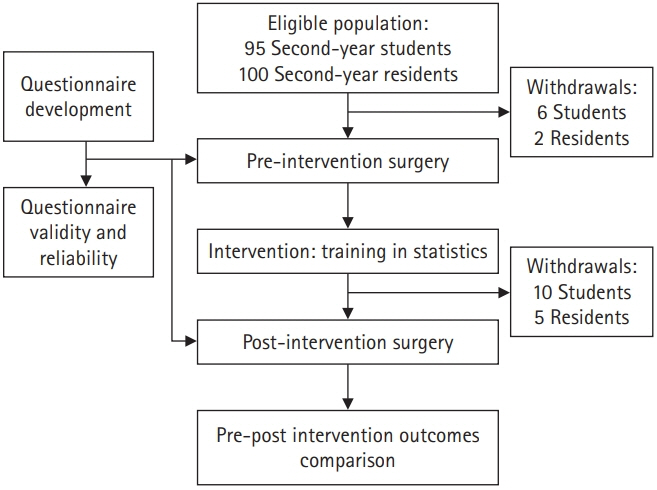J Educ Eval Health Prof.
2020;17:25. 10.3352/jeehp.2020.17.25.
Training in statistical analysis reduces the framing effect among medical students and residents in Argentina
- Affiliations
-
- 1Biostatistics, School of Medicine, Austral University, Buenos Aires, Argentina
- 2School of Medicine, Buenos Aires University, Buenos Aires, Argentina
- KMID: 2507069
- DOI: http://doi.org/10.3352/jeehp.2020.17.25
Abstract
- Purpose
The framing effect refers to a phenomenon wherein, when the same problem is presented using different representations of information, people make significant changes in their decisions. This study aimed to explore whether the framing effect could be reduced in medical students and residents by teaching them the statistical concepts of effect size, probability, and sampling for use in the medical decision-making process.
Methods
Ninety-five second-year medical students and 100 second-year medical residents of Austral University and Buenos Aires University, Argentina were invited to participate in the study between March and June 2017. A questionnaire was developed to assess the different types of framing effects in medical situations. After an initial administration of the survey, students and residents were taught statistical concepts including effect size, probability, and sampling during 2 individual independent official biostatistics courses. After these interventions, the same questionnaire was randomly administered again, and pre- and post-intervention outcomes were compared among students and residents.
Results
Almost every type of framing effect was reproduced either in the students or in the residents. After teaching medical students and residents the analytical process behind statistical concepts, a significant reduction in sample-size, risky-choice, pseudo-certainty, number-size, attribute, goal, and probabilistic formulation framing effects was observed.
Conclusion
The decision-making of medical students and residents in simulated medical situations may be affected by different frame descriptions, and these framing effects can be partially reduced by training individuals in probability analysis and statistical sampling methods.
Keyword
Figure
Reference
-
References
1. Norman GR, Monteiro SD, Sherbino J, Ilgen JS, Schmidt HG, Mamede S. The causes of errors in clinical reasoning: cognitive biases, knowledge deficits, and dual process thinking. Acad Med. 2017; 92:23–30. https://doi.org/10.1097/ACM.0000000000001421.
Article2. Peng J, Li H, Miao D, Feng X, Xiao W. Five different types of framing effects in medical situation: a preliminary exploration. Iran Red Crescent Med J. 2013; 15:161–165. https://doi.org/10.5812/ircmj.8469.
Article3. Peng J, Jiang Y, Miao D, Li R, Xiao W. Framing effects in medical situations: distinctions of attribute, goal and risky choice frames. J Int Med Res. 2013; 41:771–776. https://doi.org/10.1177/0300060513476593.
Article4. Akl EA, Oxman AD, Herrin J, Vist GE, Terrenato I, Sperati F, Costiniuk C, Blank D, Schunemann H. Framing of health information messages. Cochrane Database Syst Rev. 2011; (12):CD006777. https://doi.org/10.1002/14651858.CD006777.pub2.
Article5. Gong J, Zhang Y, Yang Z, Huang Y, Feng J, Zhang W. The framing effect in medical decision-making: a review of the literature. Psychol Health Med. 2013; 18:645–653. https://doi.org/10.1080/13548506.2013.766352.
Article6. Reilly JB, Ogdie AR, Von Feldt JM, Myers JS. Teaching about how doctors think: a longitudinal curriculum in cognitive bias and diagnostic error for residents. BMJ Qual Saf. 2013; 22:1044–1050. https://doi.org/10.1136/bmjqs-2013-001987.
Article7. Ogdie AR, Reilly JB, Pang WG, Keddem S, Barg FK, Von Feldt JM, Myers JS. Seen through their eyes: residents’ reflections on the cognitive and contextual components of diagnostic errors in medicine. Acad Med. 2012; 87:1361–1367. https://doi.org/10.1097/ACM.0b013e31826742c9.
Article8. Sherbino J, Yip S, Dore KL, Siu E, Norman GR. The effectiveness of cognitive forcing strategies to decrease diagnostic error: an exploratory study. Teach Learn Med. 2011; 23:78–84. https://doi.org/10.1080/10401334.2011.536897.
Article9. Sherbino J, Kulasegaram K, Howey E, Norman G. Ineffectiveness of cognitive forcing strategies to reduce biases in diagnostic reasoning: a controlled trial. CJEM. 2014; 16:34–40. https://doi.org/10.2310/8000.2013.130860.
Article10. Smith BW, Slack MB. The effect of cognitive debiasing training among family medicine residents. Diagnosis (Berl). 2015; 2:117–121. https://doi.org/10.1515/dx-2015-0007.
Article11. Masel J, Humphrey PT, Blackburn B, Levine JA. Evidence-based medicine as a tool for undergraduate probability and statistics education. CBE Life Sci Educ. 2015; 14:ar42. https://doi.org/10.1187/cbe.15-04-0079.
Article12. Borracci RA, Pineiro DJ, Arribalzaga EB. Effects of presenting risk information in different formats to cardiologists: a Latin American survey. Arch Cardiol Mex. 2015; 85:3–8. https://doi.org/10.1016/j.acmx.2014.09.003.
Article13. Thomas AK, Millar PR. Reducing the framing effect in older and younger adults by encouraging analytic processing. J Gerontol B Psychol Sci Soc Sci. 2012; 67:139–149. https://doi.org/10.1093/geronb/gbr076.
Article14. Bigman CA, Cappella JN, Hornik RC. Effective or ineffective: attribute framing and the human papillomavirus (HPV) vaccine. Patient Educ Couns. 2010; 81 Suppl:S70–S76. https://doi.org/10.1016/j.pec.2010.08.014.
Article15. Cook DA. If you teach them, they will learn: why medical education needs comparative effectiveness research. Adv Health Sci Educ Theory Pract. 2012; 17:305–310. https://doi.org/10.1007/s10459-012-9381-0.
Article16. Huang Y, Wang L. Sex differences in framing effects across task domain. Pers Individ Dif. 2010; 48:649–653. https://doi.org/10.1016/j.paid.2010.01.005.
Article17. Best R, Charness N. Age differences in the effect of framing on risky choice: a meta-analysis. Psychol Aging. 2015; 30:688–698. https://doi.org/10.1037/a0039447.
Article18. Seo MG, Goldfarb B, Barrett LF. Affect and the framing effect within individuals over time: risk taking in a dynamic investment simulation. Acad Manage J. 2010; 53:411–431. https://doi.org/10.5465/AMJ.2010.49389383.
Article19. Sundelin T, Bayard F, Schwarz J, Cybulski L, Petrovic P, Axelsson J. Framing effect, probability distortion, and gambling tendency without feedback are resistant to two nights of experimental sleep restriction. Sci Rep. 2019; 9:8554. https://doi.org/10.1038/s41598-019-44237-9.
Article20. Zhen S, Yu R. All framing effects are not created equal: low convergent validity between two classic measurements of framing. Sci Rep. 2016; 6:30071. https://doi.org/10.1038/srep30071.
Article
- Full Text Links
- Actions
-
Cited
- CITED
-
- Close
- Share
- Similar articles
-
- Correlations between moral courage scores and social desirability scores among medical residents and fellows in Argentina
- Effectiveness of limited airway ultrasound education for medical students: a pilot study
- A Survey about Improvements of Clinical Training in Medical Students
- The differences in self-efficacy in clinical performance between medical students and residents
- Empathy and tolerance of ambiguity in medical students and doctors participating in art-based observational training at the Rijksmuseum in Amsterdam, the Netherlands: a before-and-after study


